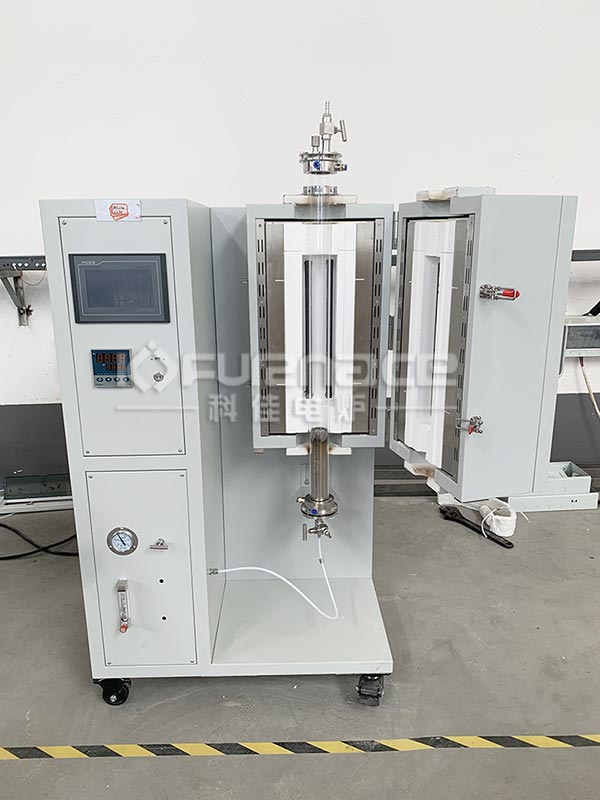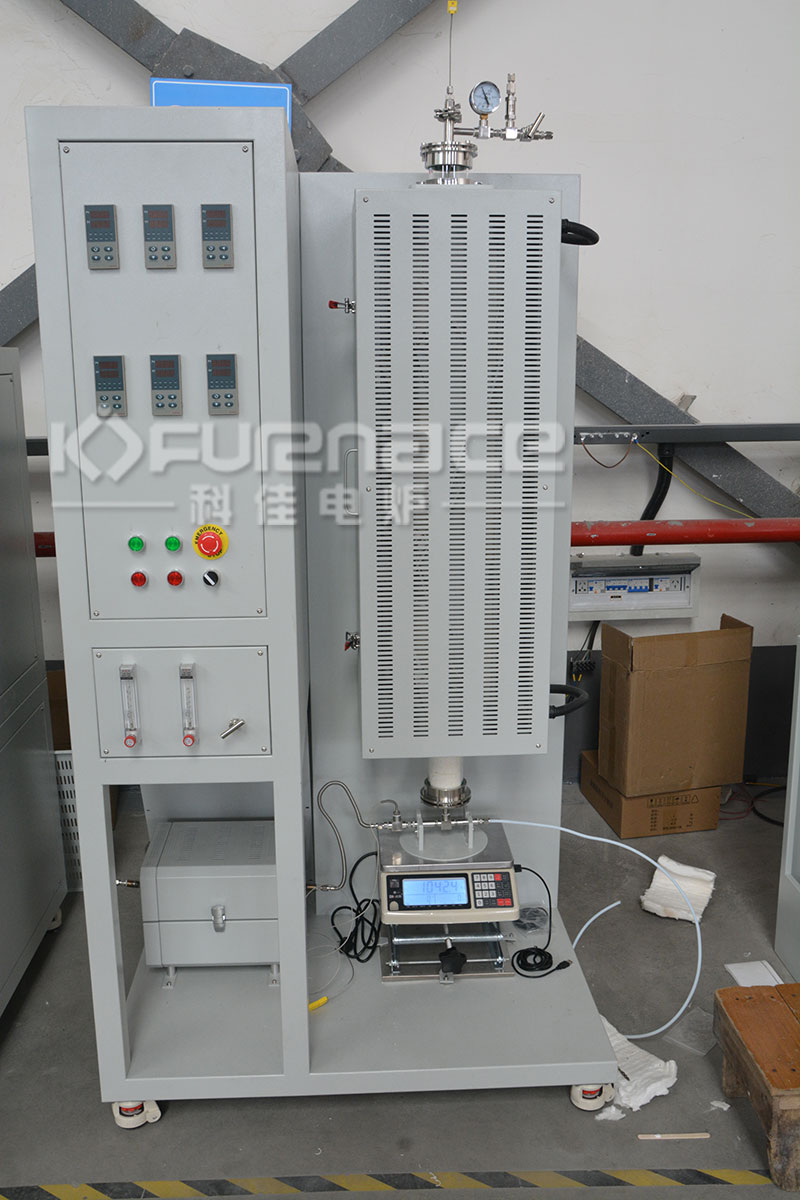Vertical tube furnace combined with fluidized bed technology (i.e. vertical tube fluidized bed furnace) is a commonly used equipment that combines the efficient heat and mass transfer characteristics of fluidized beds with the compact structure advantages of vertical tube furnaces, and is widely used in fields such as chemical engineering, energy, and environmental protection. So what are its benefits? Let’s take a detailed look below!

KJ-1100-V60 fluidized bed tube furnace (click on the picture to view product details)
1. Efficient heat and mass transfer, improving reaction efficiency
Strengthen gas-solid contact
Fluidized bed drives solid particles through gas blowing, keeping the material in a suspended or boiling state, greatly increasing the gas-solid contact area and reaction rate.
Uniform temperature distribution
Solid particles are continuously mixed in a fluidized state to eliminate local overheating or temperature gradients, ensuring temperature uniformity inside the furnace (temperature difference can be controlled within ± 5 ℃).
Advantage: Avoid material clumping or incomplete reaction caused by uneven temperature, and improve product quality stability.
High heat transfer coefficient
The heat transfer coefficient of fluidized bed is high, which can greatly shorten the reaction time.
Application: In high-temperature reactions such as petroleum cracking and catalyst regeneration, it can reduce energy consumption and increase unit time yield.
2. Flexible operability and adaptability
Wide load adjustment range
By adjusting the gas flow rate or solid circulation volume, load regulation can be easily achieved to adapt to production fluctuations.
Scenario: In chemical production, there is a need to frequently adjust production volume (such as producing according to orders).
Multi material compatibility
It can handle materials with significant differences in particle size and density, such as coal powder, catalyst particles, biomass, etc., and is not prone to blockage or segregation.
Case: In the pyrolysis of waste tires, mixed materials such as rubber particles and metal fibers can be processed simultaneously.
Online operation and maintenance
The solid particle circulation system supports continuous feeding and slag discharge without the need for shutdown cleaning, reducing unplanned downtime.
Advantage: Suitable for industrial processes that require long-term continuous operation, such as power generation and chemical synthesis.
3. Environmental protection and energy-saving advantages
Low pollution emissions
The temperature inside the fluidized bed is uniform, which can effectively suppress the generation of thermal NOx.
Application: Coal fired boilers, waste incinerators and other equipment that meet strict environmental requirements.
Efficient waste heat recovery
The vertical structure is compact, the flue gas process is short, and it is easy to integrate waste heat recovery devices (such as air preheaters), resulting in higher thermal efficiency.
Case: In biomass gasification, waste heat can be used to preheat raw materials or generate steam, reducing overall energy consumption.
4. Compact structure and space optimization
Vertical design saves floor space
Compared to horizontal fluidized beds, vertical structures are highly concentrated and occupy less space, making them suitable for factories with limited space.
Scenario: Urban waste incineration plants, chemical parks, laboratories and other areas with high land costs.
Modular design facilitates expansion
Modules can be stacked according to production capacity requirements (such as adding fluidized bed units or heat exchange modules) to achieve rapid expansion.
Advantage: Reduce initial investment while reserving space for future upgrades.
5. Typical application scenarios
chemical engineering field
Catalyst regeneration: Deactivate the catalyst through high-temperature treatment in a fluidized bed to restore its activity (such as FCC catalyst regeneration).
Petroleum cracking: Efficient cracking of light hydrocarbons in a vertical tube furnace to increase olefin yield.
energy sector
Biomass gasification: converting agricultural and forestry waste into synthetic gas (CO+H ₂) for power generation or chemical raw materials.
Environmental protection field
Pyrolysis of waste tires: Decompose tires into fuel oil, carbon black, and steel wire to achieve resource recovery.
Sludge treatment: Incinerate sludge through high-temperature fluidized bed to reduce volume and kill pathogens.
6. Selection suggestions
Select based on material characteristics
Fine particulate materials: Priority should be given to high-speed fluidized beds (such as circulating fluidized beds) to avoid particle entrainment.
Easy to bond materials: Use furnace bodies lined with wear-resistant materials or add inert particles to prevent clumping.
Match process requirements
High temperature reaction: Choose high-temperature resistant materials (such as Hastelloy, ceramic lining) and efficient sealing structures.
Continuous production: equipped with automatic feeding and slag discharge systems to reduce manual intervention.
Consider long-term costs
Evaluate equipment lifespan, maintenance frequency, and energy consumption, and choose a solution with better overall cost.
Case: A chemical enterprise found through comparison that although the initial investment of a vertical tubular fluidized bed furnace is high, the total cost over 5 years is lower than that of a horizontal fixed bed furnace.

A commonly used small fluidized bed vertical tube furnace (click on the image to view product details)
In general, vertical tubular fluidized beds have many advantages, and it is possible to communicate the parameters with relevant technical personnel before customization, so as to customize a vertical tubular fluidized bed that is more suitable for one’s own needs!Click to learn more tube furnaces! Or click on online customer service to learn more about product information!